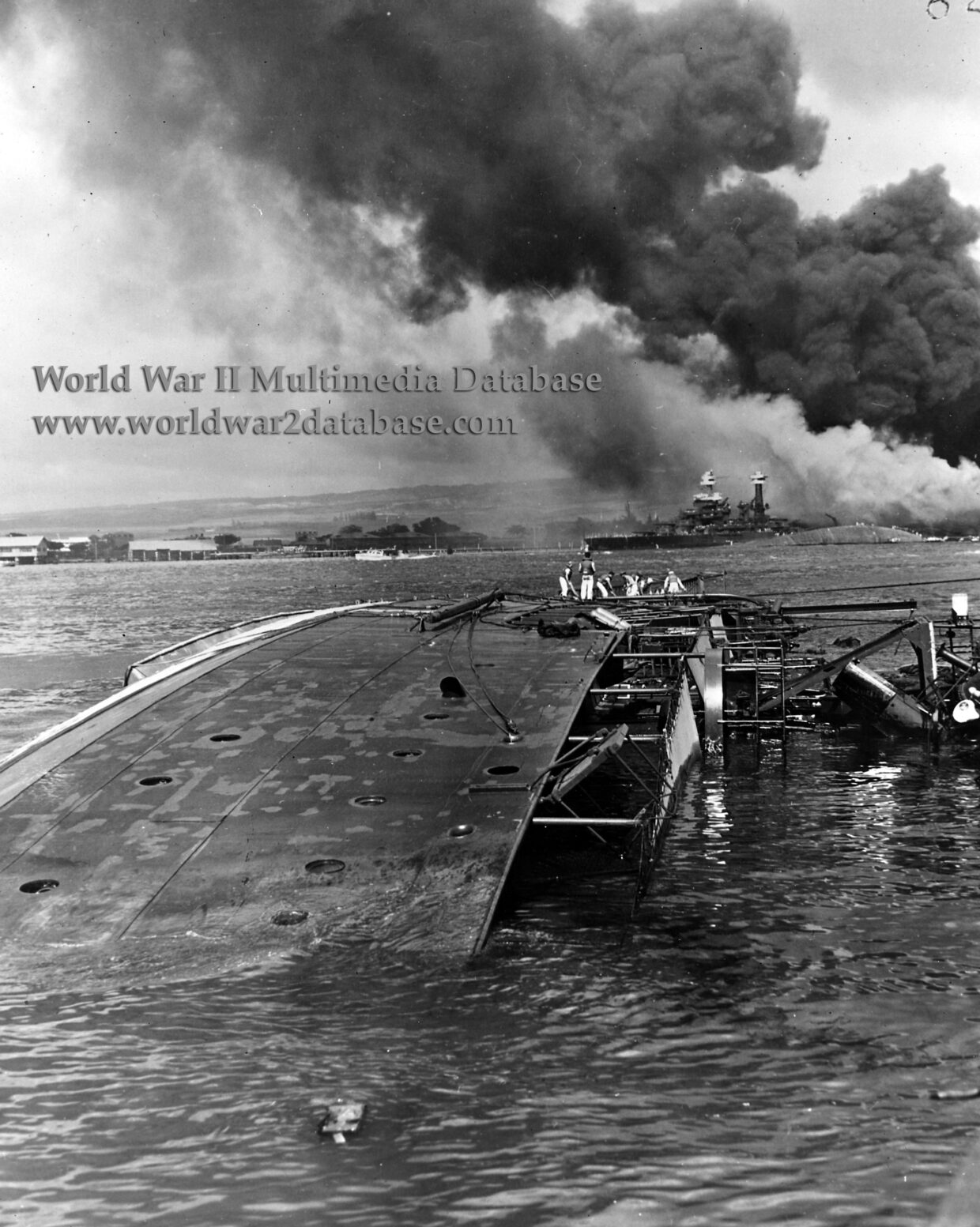| USS Oglala (CM-4) capsized alongside 1010 dock at Pearl Harbor, 9 December 1941. She was sunk during the Japanese air raid two days earlier. Preliminary salvage work on her is already underway“Battleship Row“, by Ford Island is in the distance, with USS Maryland (BB-46) in center, alongside the capsized USS Oklahoma (BB-37). At 0755 Hours on December 7, 1941, Oglala, flagship of the Pacific Fleet Mine Force, was tied up outboard of light cruiser USS Helena (CL-50). They were alongside Pier 1010 at the Pearl Harbor Navy Yard, with an eight-foot camel (pontoon) between them. Japanese Nakajima B5N2 torpedo planes from Soryu and Hiryu‘sThird and Fourth Attack Units first attack wave hit the cruiser with a single torpedo, which ran under Oglala to hit Helena‘s starboard side. The torpedo‘s explosion broke through the minelayer‘s port bilge amidships, and she rapidly took on water. A bomb that burst nearby caused further damage. With the marginal watertight integrity typical of older ships, Oglala‘s flooding could not be contained. When it became clear that she might sink, Oglala was moved aft of Helena, so she would not pin the warship against the dock. About two hours after receiving her initial damage, she rolled over to port and sank beside 1010 dock. Gordon W. Prange in At Dawn We Slept states that Chief Boilermaker John Crawford of USS Vestal (AR-4) said Oglala “died of fright“ giving rise to the legend that she sank without any damage. The stricken Oglala became the object of a prolonged, and ultimately successful salvage effort. Though Oglala was originally evaluated as a total loss, with the only salvage goal being to clear valuable pier space, it was ultimately decided to fully recover and repair the ship. The salvage effort was complex work, with the inherent difficulties of righting and refloating a capsized ship compounded by Oglala‘s poor stability. Fifteen to eighteen divers were kept busy for nearly 2000 underwater hours during the salvage, patching her hull, rigging chains, cutting away unwanted structure and executing many other tasks. After her tophamper had been removed, ten salvage pontoons were used to pull the ship upright while air was pumped into her to lighten the load. The first righting attempt, made on April 11, 1942, failed when several connecting chains parted. Fleet Admiral Chester W. Nimitz (February 24, 1885 – February 20, 1966) observed the abortive attempt. However, a second try succeeded twelve days later. Oglala was now upright, but still mostly underwater. A large wooden cofferdam was built around the edges of her decks to allow water to be removed from her interior. The ship was refloated in June, but resank during the night of June 25-26 when the failure of a pump led to cascading flooding in her forward hull. Afloat again on June 29, she promptly went down for a third time when the cofferdam failed. After another raising, a serious fire on July 2 nearly produced a fourth resubmergence. However, the next day Oglala was finally drydocked, completing a job that became a legend among marine salvors. She received temporary repairs during much of the rest of 1942 and, in December, left Pearl Harbor for the U.S. west coast, there to be refurbished for active service. | |
| Image Filename | wwii1400.jpg |
| Image Size | 1.15 MB |
| Image Dimensions | 2304 x 2886 |
| Photographer | Unknown |
| Photographer Title | United States Navy |
| Caption Author | Jason McDonald |
| Date Photographed | December 07, 1941 |
| Location | 1010 Dock |
| City | Pearl Harbor |
| State or Province | Hawaii |
| Country | United States of America |
| Archive | National Archives and Records Administration |
| Record Number | NRHS-21-DCHIHIHC-HC298-298REXH14(32) |
| Status | Caption ©2010, ©2024 MFA Productions LLC Image in the Public Domain |

Author of the World War II Multimedia Database

